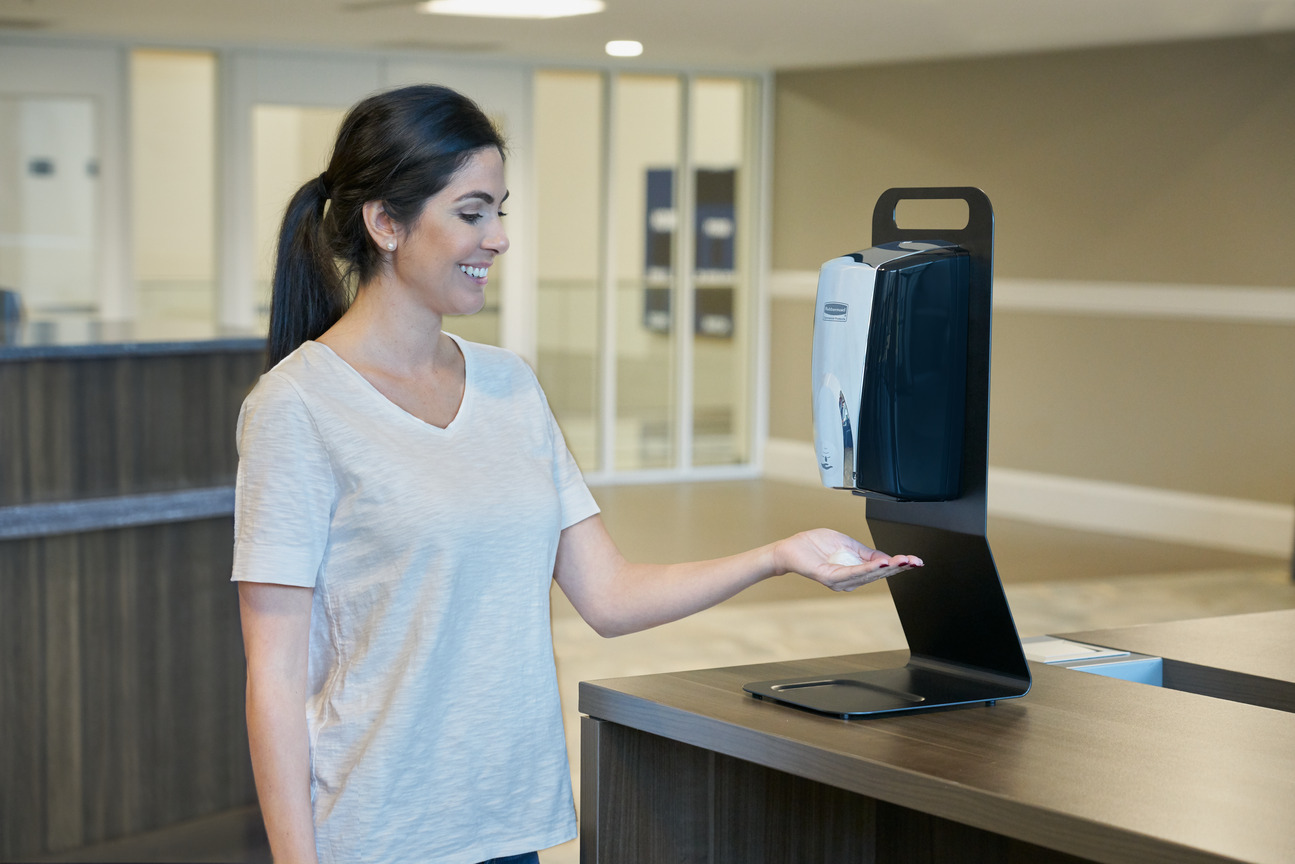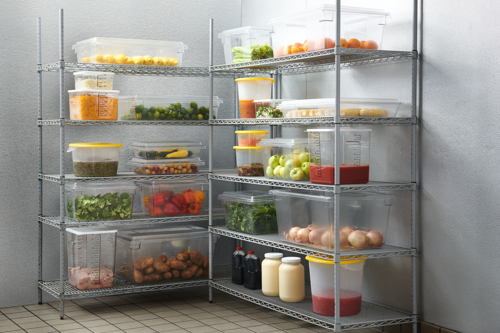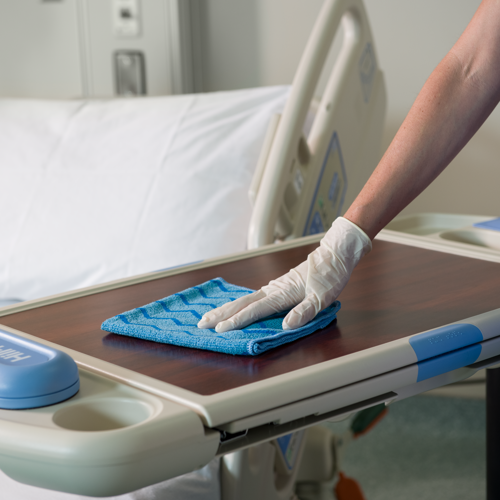
Understanding and preventing cross-contamination is essential to safeguarding health, particularly in food preparation and healthcare settings where risks are highest. Because of this broad range of sources, cross-contamination is one of the most preventable forms of contamination in all settings, whether in businesses or homes. Rubbermaid Commercial Products offers innovative solutions to help businesses effectively manage and reduce cross-contamination risks.
What Is Cross-Contamination?
As the name states, cross-contamination is the direct or indirect transfer of harmful bacteria, viruses or allergens from one surface, object, or person to another. This process can occur in various settings, but it is most commonly associated with food preparation and healthcare environments. The risks it poses, such as foodborne illnesses and contamination in sterile spaces, make it a critical issue to address.
In food service, cross-contamination frequently happens when high-risk items such as raw fish or poultry come into contact with cooked food or fresh produce. For example, bacteria from raw chicken can spread to ready-to-eat meals if utensils or cutting boards aren’t properly sanitised, causing significant health hazards
In healthcare, it is critical to ensure that practices prevent cross-contamination at all times. For instance, healthcare workers must avoid transferring contaminants from medical waste to sterile instruments by adhering to strict hygiene protocols, such as effective handwashing and proper equipment handling. These measures help safeguard patient safety and maintain sterile environments.
Human contact plays a central role in spreading bacteria and allergens. Whether it’s through handling raw food, touching equipment, or failing to wash hands effectively, cross-contamination remains a preventable yet persistent issue. Recognising and addressing these patterns is key to maintaining safe and hygienic environments in both food service and healthcare settings. As noted in the examples, cross-contamination always involves a force, such as a food handler or healthcare worker moving items from one place to another.
Types of Cross-Contamination
There are several ways that cross-contamination can happen, and each one has serious health hazards if improperly handled. Effective prevention requires an understanding of these types:
1. Food-to-food: When raw foods, like meat or shellfish, come into touch with cooked or ready-to-eat foods, harmful germs or allergens can spread. Raw chicken stored above fresh produce, for instance, may leak juices that contain Salmonella and other dangerous pathogens. This kind of contamination frequently happens as a result of incorrect food handling or storage.
2. Equipment-to-food: When utensils, surfaces, or instruments aren't properly cleaned after use, contamination can spread. Pathogens are introduced to safe food, for example, when the same cutting board is used for raw fish and cooked chicken without being cleaned. This emphasises the importance of following the right cleaning and sanitisation protocols, especially in high-risk locations like kitchens or medical institutions.
3. Person-to-food: When appropriate hygiene procedures aren't followed, human handling is a major source of contamination. Two examples are unwashed hands preparing food or touching prepared food after handling raw components. These dangers can be reduced by using touch-free instruments or by wearing gloves.
4. Person-to-person: In high-risk situations, germs can spread by direct or indirect contact, such as handshakes, equipment sharing, or failure to wear personal protective equipment (PPE). This is particularly concerning in healthcare or hospitality environments, where one sick individual can rapidly facilitate the transmission of bacteria, viruses or illnesses to others.
5. Environment-to-food: Bacteria can transfer from surfaces such as storage spaces, doorknobs and counters to food. Pathogens like Listeria flourish in damp, unclean environments, which highlights the importance of routine cleaning with the right disinfectants.
Tips On How To Avoid Cross-Contamination
Addressing the primary routes of bacterial transmission is necessary to prevent cross-contamination. Everyone is kept safer by emphasising cleanliness, hygiene and appropriate handling.
1. Hand Hygiene
As the hands are the most used part of the body in all jobs, it’s no surprise that they are the leading cause of cross-contamination. It is important to note that some instances of cross-contamination are accidental. However, the most prevalent ways that bacteria spread within a business is due to staff either not washing their hands or not washing their hands effectively. Proper handwashing is critical in preventing the spread of bacteria, as it helps eliminate harmful pathogens before they can transfer to other surfaces or individuals. It’s essential that staff are not only made aware of the best handwashing practices, but that they are constantly retrained on how to do so. From infection control in childcare to infection control in hospital food service, this can significantly reduce the bacteria that spreads in a business and can promote a safer environment.
Handwashing alone is not enough to completely prevent cross-contamination in businesses. These facilities must have the appropriate hand soap and hand soap dispensers to guarantee that bacteria is removed from the skin effectively. Rubbermaid’s touch-free hand sanitisers are ideal for high-traffic environments, offering a quick and efficient way to kill bacteria when handwashing is not immediately accessible. Where handwashing may be limited due to the sink locations in a business, touch-free hand sanitisers can provide quick bacteria-eradicating solutions for staff. 
Maintaining hand hygiene is particularly important in healthcare settings due to the risk of patient-to-patient cross-contamination. Ensuring that healthcare workers adhere to strict handwashing protocols is crucial for effective disease control and preventing the spread of biological contamination.
This involves regular training on hand hygiene practices tailored to tackle different types of contaminants, including harmful microorganisms and allergens. In many cases, healthcare facilities implement comprehensive monitoring systems to ensure compliance and effectiveness of these practices, which reduces the potential for cross-contamination and safeguards patient health.
2. Surface Cleaning and Sanitising
Surfaces that remain unclean and unsanitised for periods of time can begin to harbour harmful bacteria. This is especially true if these surfaces come into contact with several external sources, such as people’s hands and food. Surfaces are also not limited to benches and tabletops. Countertops, cutting boards, utensils and even handles on equipment can be considered a surface. Businesses should adopt a comprehensive cleaning approach, addressing not just visible dirt but also the unseen bacteria that accumulate on these high-touch surfaces. They need to consider the entire ecosystem of their premises. More than this, it’s essential that the right cleaning and sanitisation tools are used.
Rubbermaid’s HYGEN Microfibre Cloth range offers a specialised solution for surface cleaning and sanitising. These cloths are designed with advanced microfibre technology, which effectively traps and locks in pathogens, preventing bacteria from re-spreading immediately after cleaning. The HYGEN range can be used with or without chemicals, offering flexibility for businesses aiming to reduce chemical use while maintaining high levels of hygiene.
The Disposable Microfibre Cloths from Rubbermaid also offer a sanitary and practical solution for one-time cleaning duties, guaranteeing that pathogens are contained and disposed of after every use. When cross-contamination is an issue in high-risk settings, these are especially helpful. When assessing their cleaning requirements, businesses should think about whether disposable or long-lasting microfibre options — or a mix of the two — are best for their operations.
Though they can sanitise effectively without the use of chemicals, businesses should consider the surface they are working on and determine if a cleaning chemical can promise a higher level of cleanliness.
3. Using Personal Protective Equipment
All businesses, in some form or another, will have people. This may include their staff for office jobs or customers for service or product-based businesses. People can become a source of cross-contamination when sick, have open wounds or have come into contact with bacteria. The use of proper protective measures and practices is essential to minimise the spread of harmful microorganisms.
Cross-contamination from person to person can be prevented through the right cleaning supplies and practices. Rubbermaid’s range of Personal Protective Equipment (PPE), including gloves, masks and gowns, is specifically designed to offer an additional layer of protection against bacterial transfer. These tools are particularly vital in high-risk environments like healthcare, where interactions often involve handling contaminated materials or direct contact with patients.
Cross-contamination acts like a cycle. If a surface contains harmful bacteria and a person comes into contact with it, they are now infected. From office cleaning supplies to restaurant cleaning supplies, having the right tools in place can keep premises free from bacteria and, inversely, stop people from passing infection on to one another. Using hot, soapy water for regular cleaning can also be particularly effective in removing bacteria from various surfaces
While sick days slow production, it is also critical that business owners take the responsibility of sending sick staff home to prevent the spread of bacteria. Social distancing is encouraged during cold and flu season.
In healthcare settings, the use of PPE is non-negotiable. Gloves, gowns, masks and eye protection are crucial in blocking the transfer of infectious agents, ensuring both patient and worker safety. Rubbermaid offers reliable PPE solutions to enhance safety protocols and prevent cross-contamination effectively. These measures, combined with regular training and enforcement, safeguard health in even the most vulnerable environments.
4. Proper Food Storage and Handling
As mentioned above, food can be one of the most common sources of cross-contamination. Food such as meat, poultry, seafood and some fresh produce contain harmful bacteria. These are considered high-risk and must only be handled by those with the right certifications and training. Safe food storage and handling practices are essential to prevent bacterial transfer and foodborne illnesses.
Staff should ensure that raw and cooked foods are always stored separately to avoid cross-contamination. Rubbermaid’s range of food storage containers is specifically designed to maintain proper segregation and protect against bacterial transfer. These containers help preserve freshness while ensuring that raw food, such as meat or seafood, does not come into contact with cooked dishes or fresh produce.
Cooking and food processing procedures must also follow strict food safety protocols, including maintaining proper temperature control to prevent food poisoning. Temperature control is critical to ensure that contaminated food does not become a breeding ground for bacteria.
Rubbermaid’s food storage solutions are also ideal for managing allergens and gluten-containing items. By using separate containers and designated storage areas, businesses can avoid cross-contact and provide safer options for guests with dietary restrictions.
Preventing Foodborne Illness Through Effective Cleaning and Sanitising
Proper cleaning and sanitising are essential in creating a safe environment where bacteria cannot thrive or spread, especially in high-risk areas like commercial kitchens and food preparation zones. When food is handled incorrectly or on dirty surfaces, harmful microorganisms can grow rapidly and cause foodborne diseases. Effective sanitisation not only safeguards the health of customers and staff but also upholds the reputation of your business by ensuring compliance with food safety standards.
A wide variety of cleaning products designed for high-risk settings are available from Rubbermaid Commercial Products:
Hand hygiene solutions: Touch-free sanitisers and soap dispensers for maintaining impeccable hand cleanliness.
HYGEN™ microfibre tools: Advanced cleaning cloths and mop pads designed to trap and remove 99.9% of pathogens effectively.
Durable food storage containers: Ensure safe food segregation and storage to minimise cross-contamination risks.
You can create a clean, food-safe work environment that satisfies the highest industry requirements by incorporating these innovative tools into your regular cleaning regimen.
Rubbermaid Commercial Products Is Here To Help
Preventing cross-contamination is essential to maintaining health and safety in any environment, from kitchens to healthcare settings. Rubbermaid Commercial Products offers a comprehensive range of innovative solutions, including washroom products, food storage containers and cleaning tools, to help you safeguard your facility.
Take the next step toward creating a cleaner, safer space. Browse products to prevent cross-contamination and discover how Rubbermaid can support your business in maintaining the highest hygiene standards.